How The Kroleski Family Does Toys – Our Rotation Process
Being the aspiring minimalists we are, my wife and I brought our first child home to our small apartment that had very few baby toys in it – everything fit in/on a toy box that sat on our bay window seat.
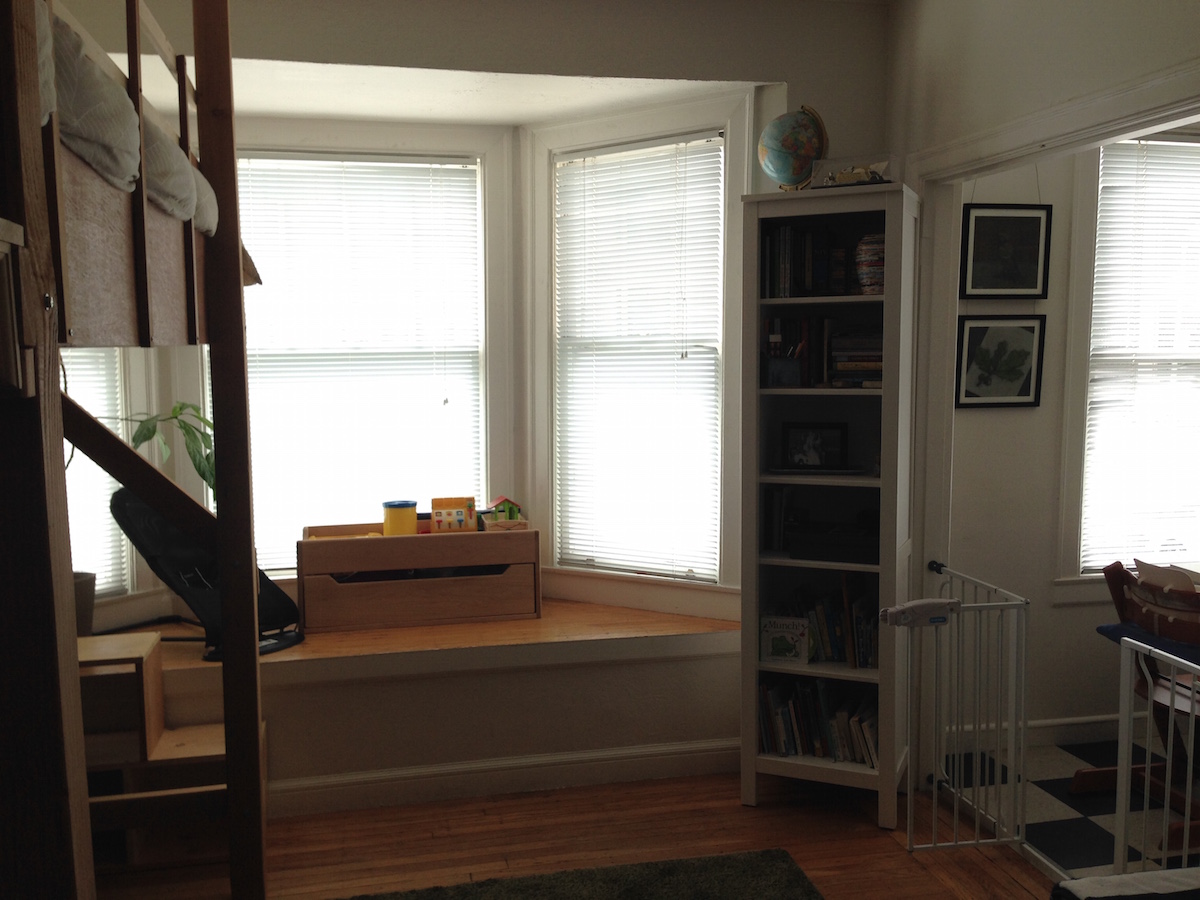
Over the three years that followed, despite our best intentions, our house has accumulated many more toys. Though they are individually great – the trouble with toys, as is the trouble with most things, is that their value does not scale linearly. More toys does not equal more fun or more learning. There are diminishing returns. Eventually even negative returns where more toys results only in more mess, stress and frustration.

A knee-jerk reaction might be to get rid of most everything – to go full minimalist. While that reaction will provide some benefits, we feel it would be throwing the baby out with the bath water.
We are attempting to get the best of both worlds via a toy philosophy and rotation process that I will describe below.
First Principles
I should mention early that toys are just one of the ways our children spend their play time (time excluding sleep and meals). As we thought about it we realized it probably only makes up ~15-30% of their time – variance by age & season. Books, crafts, outdoor activities, indoor physical play (wrestling, dancing, etc.), talking and simply looking out the window make up the rest of the time. Screen time is negligible.
Since this post is focused on toys, however, it might seem as though they are a more significant part of our life so I wanted to include that comment.
Now I will set some context for the world toys exist in and the purpose we intend them for. Here are three sets of factors we kept in mind while creating our optimized solution.
The Purpose of Toys
To discuss the purpose of toys we must discuss the purpose of child rearing. (We could go so far as to discuss the purpose of life, but I suspect this post will be long enough as is.)
In the Kroleski Family we view it as our parental responsibility to teach our children the skills they need to thrive in this world and fulfill the mission they were created for.
I personally think of it as having ~18 years to train a deep learning system before setting it loose on the world.
This is a top life priority for my wife and me. She is a full time mom (+housekeeper) and even though I spend the majority of my day working in an office, child rearing is not an afterthought.
With all of that in mind, toys help us in a few ways:
- They are an appropriate object to focus energy on – as opposed to something they shouldn’t touch, a vase, a knife, etc.
- They serve as tools to help us equip them with important skills and concepts – fine motor skills, cause & effect, creativity, focus, etc.
- They are fun and entertaining – which is a good thing in itself and also helps the parents be able to focus on other things at times.
I should note here that I am limiting my discussion to toys. In our house this doesn’t include books, craft items (crayons, playdough, paint, etc.), certain furniture-like objects (rocking horse) or outdoor gear (bikes, camping gear, etc.) – each of which has their own (though somewhat similar) system.
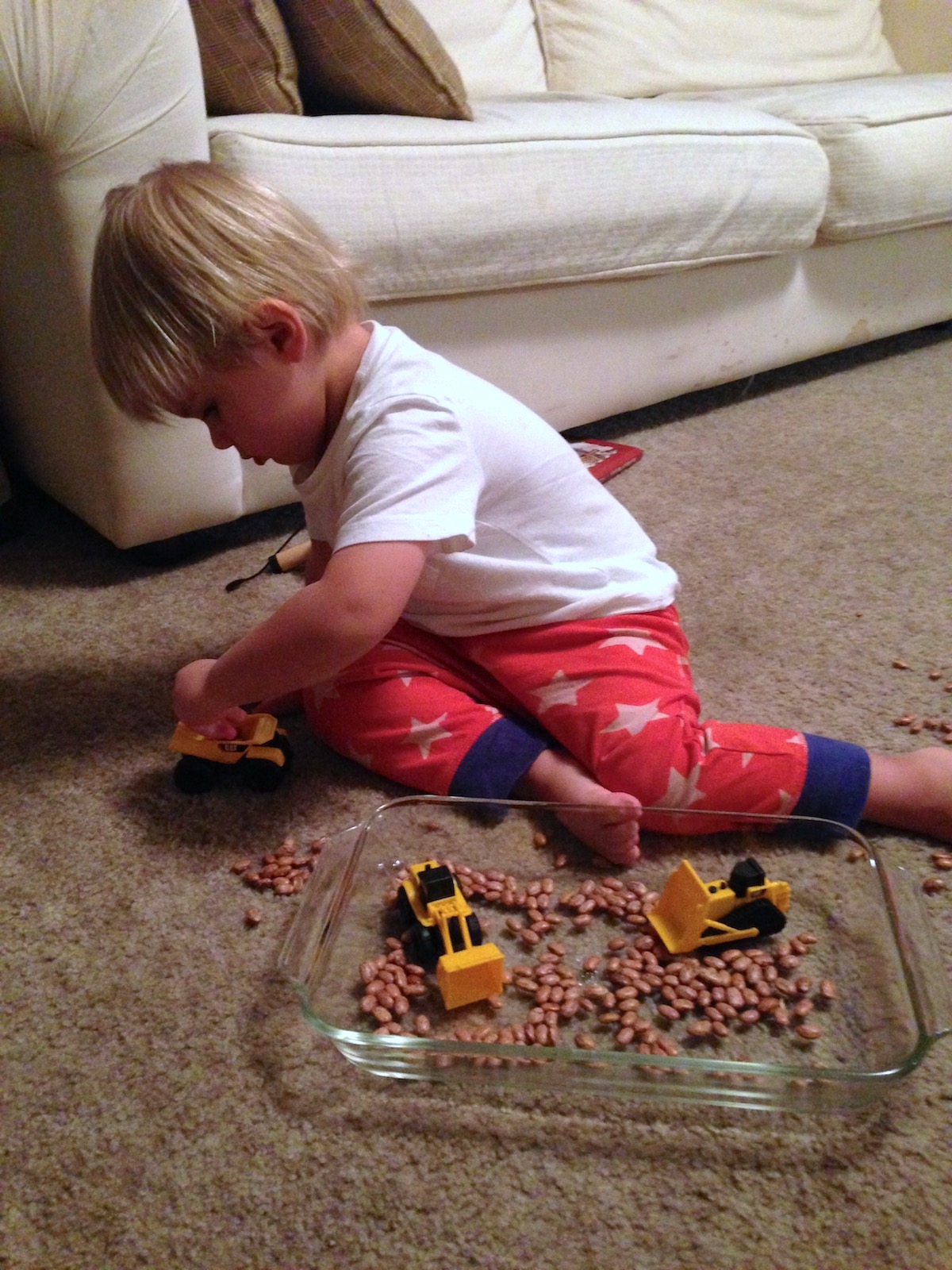
Other Factors to Consider
Toys and children present some other limiters, trade offs and circumstances that must be kept in mind as well:
- Some toys are only appropriate or engaging during certain developmental windows
- Children can become overwhelmed quite easily as they are still developing focusing & coping capacities – toys can cause this both individually and collectively through overstimulation.
- Children can become fixated on toys as objects of desire which can be disruptive to the child rearing process
- Parents play with children and enjoy variety
- Many people enjoy giving gifts and toys are a mainstay gift for children – this includes friends and especially grandparents
- Children and parents tire of doing the same thing for long periods or repeatedly
- There is an opportunity cost of not presenting children with new challenges
Our Minimalist House
Finally, we must account for their environment. These toys are physical objects within our house, where we try to maintain a particular sense of order. We generally seek to live by the following principles:
- Everything is in its place when we go to bed at night so we wake up to a clean house and a fresh day
- Less visual distraction allows for more focus – flat surfaces are not there to host stacks of objects
- Stepping on oddly shaped & sharp objects is less desirable than not stepping on said objects
- There should be room for silence – it encourages reflection
Our Working Solutions
With the above in mind, we’ve implemented the following solutions. This is very much a living solution that will change as our children grow, we face new challenges, we bump into the limits of our current plan’s foresight and/or any of the factors above shift.
Toy Philosophy
We generally don’t view toys as something that are owned by/ associated with specific children. There are not “Hunter’s toys” or “Theo’s toys”. All of the toys in our house are items that we share. The only objects in our house that really have specific child association are their special blankets they each received when they were born.
We do enforce the idea that when someone is playing with something, another person is not allowed to take it from them without asking. Sharing, asking and proposing trades is encouraged but ultimately temporary.
This system of non-ownership is fine in the house and allows some nice benefits, but does start to break down when we are at the park as not all children have the same view about their toys. I am still working out how to resolve this but generally sharing principles apply while at the park and I work to make sure our children don’t go home with someone else’s toys.
Toys are transient. The vast majority of toys in our house were once played with by someone else (including myself or my wife when we were respectively children), all of them will get played with by multiple siblings and eventually most will all find a new home where they can be played with. I believe this mindset helps develop a better relationship with ‘stuff’ while also allowing a more full appreciation of the specialness of the present moment.
We don’t use toys as motivators. There is no concept of ‘if you do X you will be able to play with Y’ or ‘if you do X, we will get you Y’. I suspect this one gets harder as children get older, but it is something we plan to avoid.
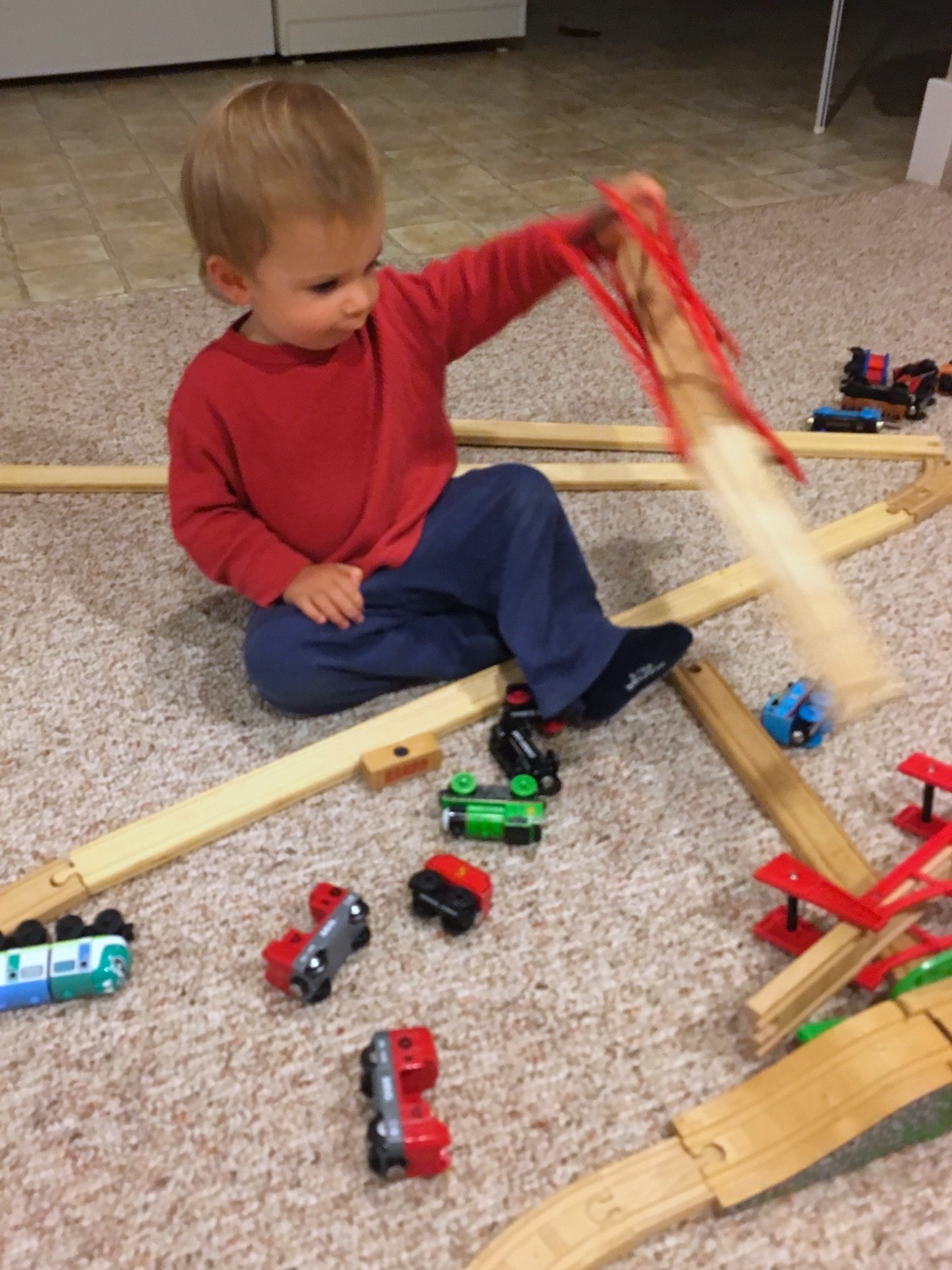
We do not use toys as a way to show our love. We do use them to some degree as means to facilitate play time together, which is how we do show our love. I am intentional around this topic because I think using objects as a sign of love can create a mental fixations on objects which can result in negative consumption behaviors later in life that are hard to break free of.
We avoid making a big deal about new toys. I’ll describe our toy process more below, but new toys are generally just introduced into the fray unwrapped and ready to play with, the same way used toys or existing toys are. I believe that making a big deal about new ownership of a toy trains the brain to overdevelop stimulus pathways that will result in future desire to purchase things, even when those things aren’t needed. I want to help my children have grander motivations.
Toy Selection
The bar a toy must be above in order to earn its stay in our house is fairly high. It must be fun to play with, able to teach something, safe, quality made and properly working. A toy might lose its keep if it breaks beyond repair or repeatedly demonstrates it isn’t capable of facilitating play. (I should note that ‘beyond repair’ is pretty hard to reach in our house because I am a fixer.)
We often supplement toys with non-toys that meet the same bar – rubber spatulas, measuring cups, delivery boxes, camping flashlights, pots & pans, etc.
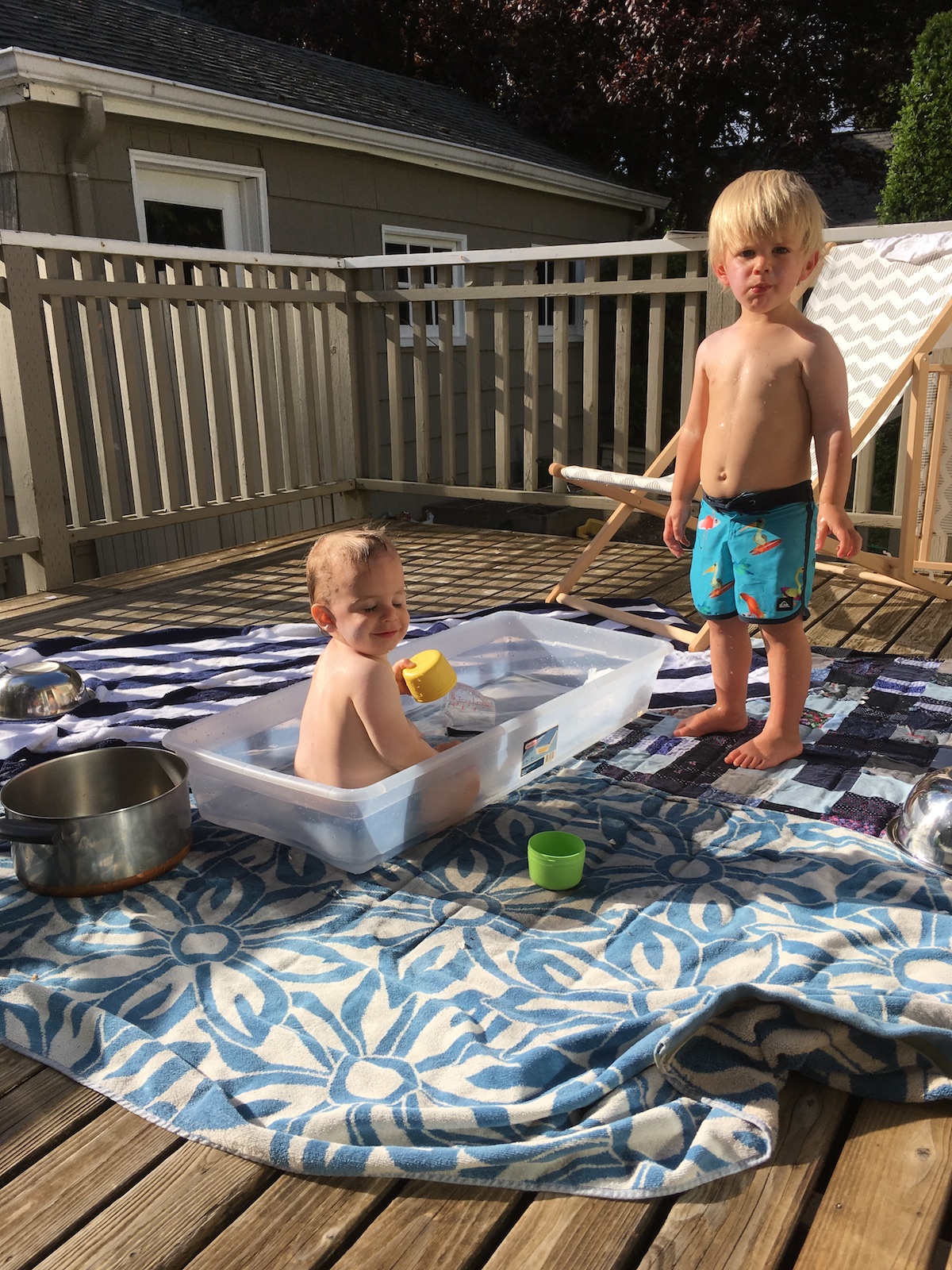
We prefer toys that do not make electronic noise. We are fine with whistles and drums, but steer away from beeping, singing and such. There are exceptions. The boy’s uncle created the first one with an electronic music box that played classical tunes. It doesn’t suffer us the experience of incessant, undesired or seemingly random commencement as most electronic-noise toys do, so it was granted stay.
We generally maintain the less is better and so try not to have a toy if another toy already serves that purpose. We aren’t running 100% lean right now though. An astute observer might notice that there are over a dozen different balls in the picture above. Our middle child really likes playing with balls and we allow a bit more there because sometimes a specific size, shape, color, texture or bounce pattern will get extra engagement on a given week. We might thin it out eventually but haven’t done so to date.
Maintaining a high bar on toy selection becomes difficult when faced with the reality of gifts – especially if you as fortunate as we are to have lots of loving and generous people around you. People close to us generally know our minimalist tendencies and try to respect them, which helps reduce overall toy input volume. We also work to try and redirect gift giving towards other things like clothes or focus it on specific types of toys we think are good. That said, sometimes grandma just really wants to get her grandson a certain toy and we practice mercy around this (to an extent).
Because the boys get plenty of new toys from others, we rarely feel anything else is needed. I’ve now been a parent for nearly three years and have yet to buy a new toy. I did purchase that train set from someone I was buying a stroller from – the boys had enjoyed playing trains with their cousin, the price was amazing and I knew we would be able to create some crazy-fun track setups – I was right.
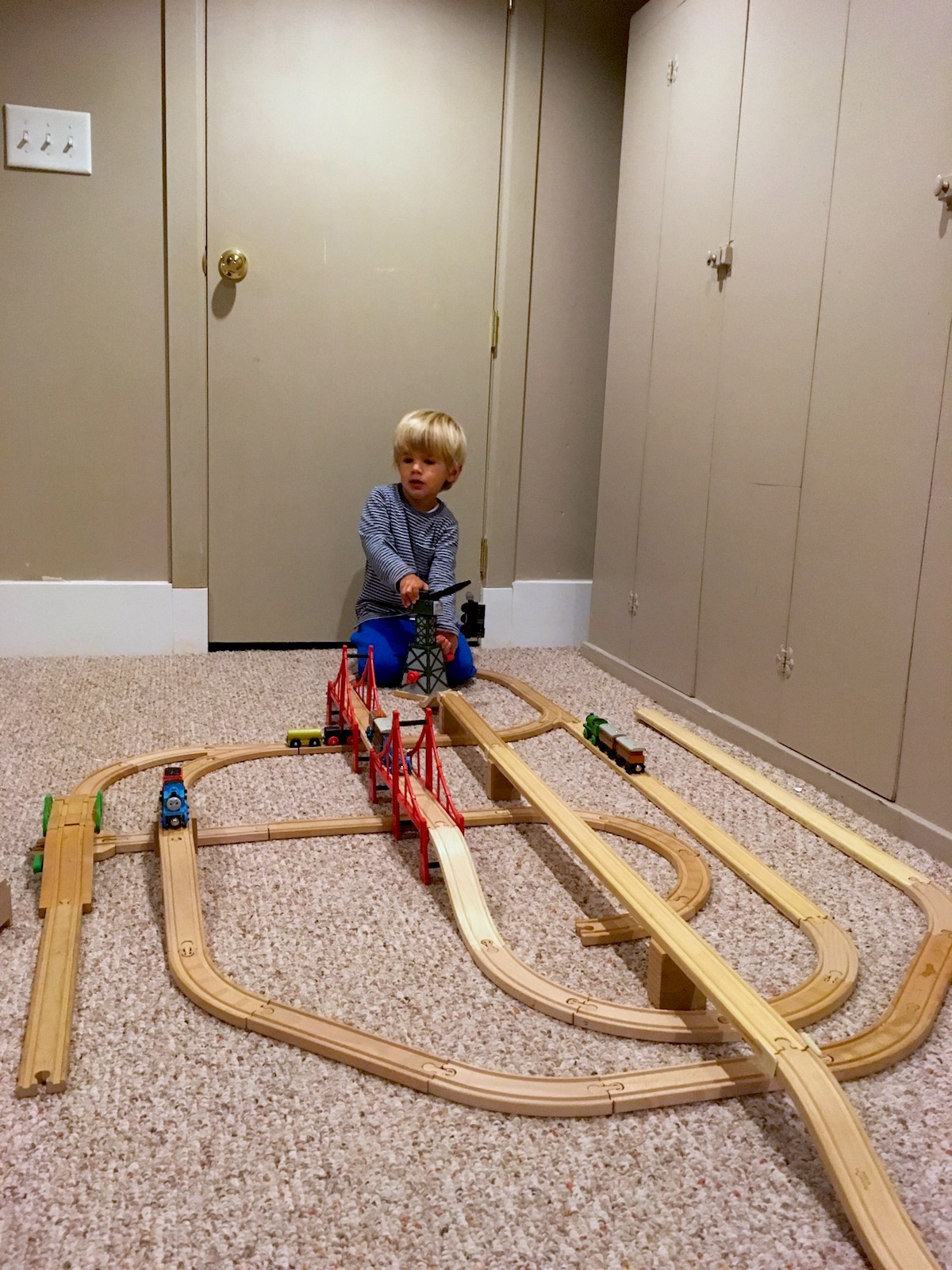
The Toy Rotation Process
We practice a rotation process with toys so that only a small amount is available to play with at any given point.
All toys permanently live in a a few storage containers in the basement and every week some small portion of those toys, comes to visit us in the house. (This shelf is showing the normal state of all of the things that are spread out in the picture at the top of this post.)
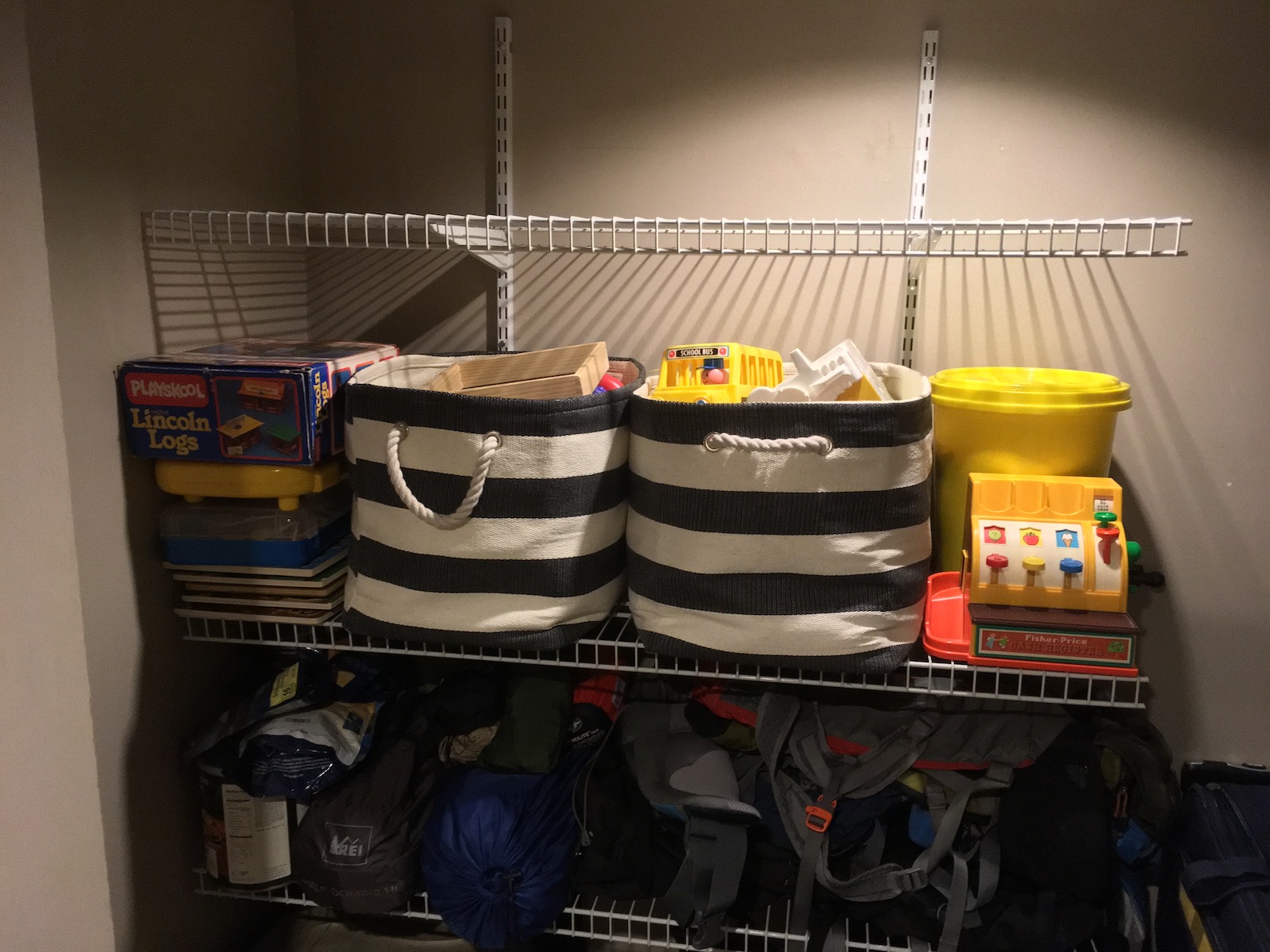
The Process
On Sunday night, while the children are sleeping, one of us parents will collect the toys from the house and switch them with items from the basement.
The process involves putting things away in zip lock bags by type to help keep things orderly – all cars go together as do puppets, etc.
We then select a few new toys that we think will be good for the coming week – I’ll write more about the selection process below.
On Monday morning the boys wake up to a fresh set of toys. It is sort of a special morning where they go to see what they have to play with for that week. It captures much of the excitement of what you might expect of a child on Christmas morning but in a way that seems healthier.
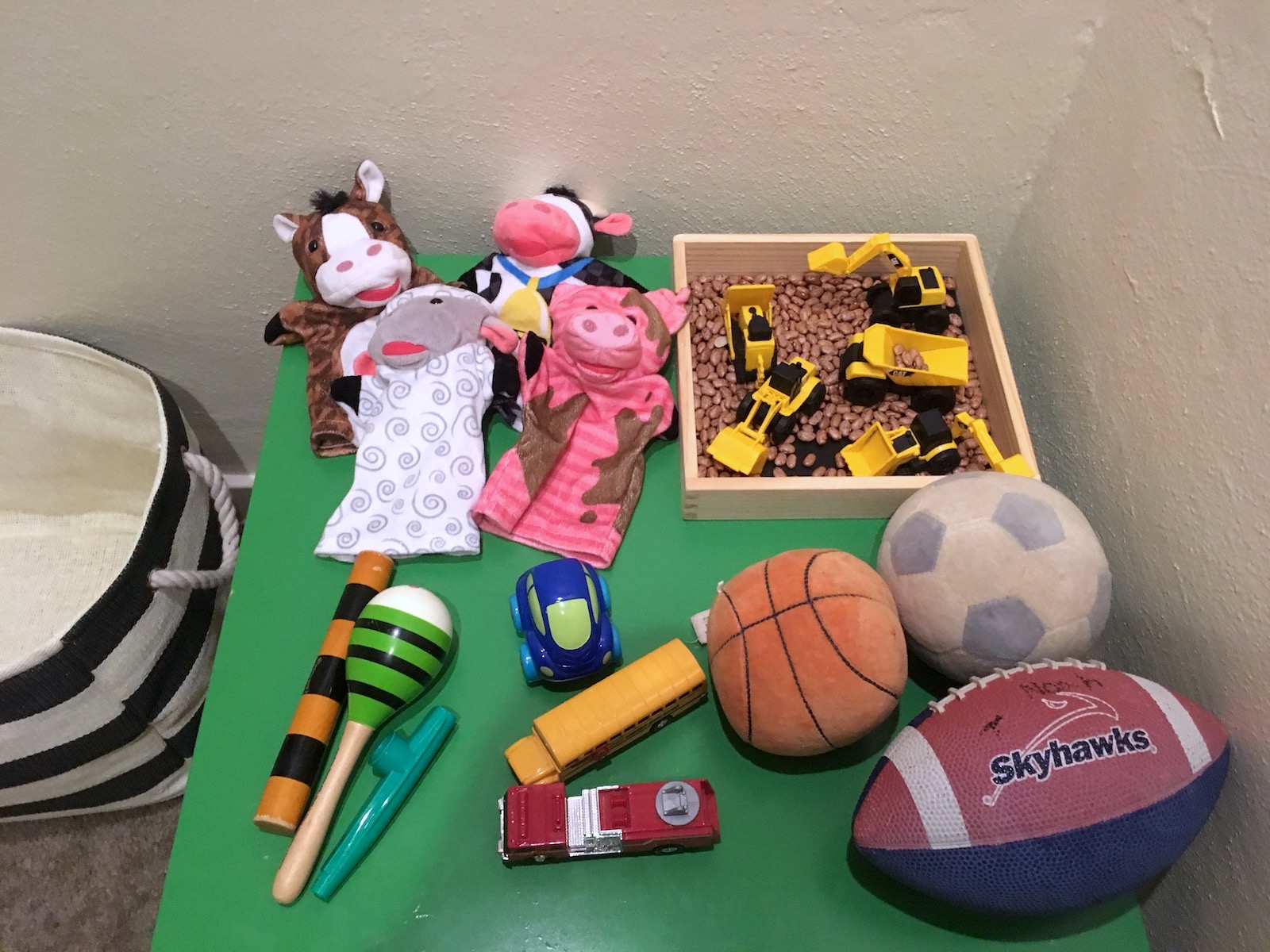
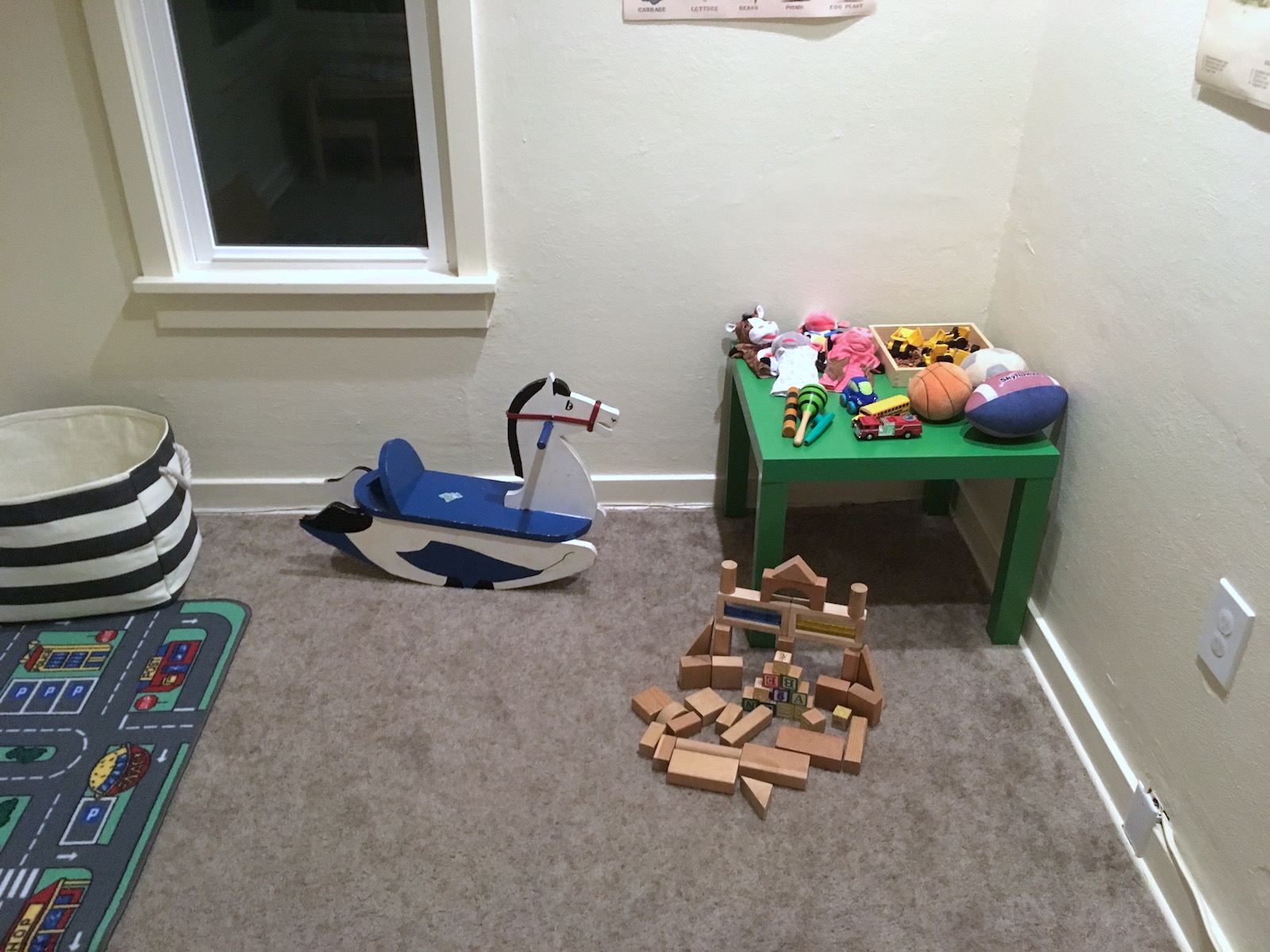
Here are two pictures of recent rotation to show you the amount of toys that get rotated in. We use that blue and white basket to rotate them and generally all toys go back in that basket at clean up time in the evening.
Toy Rotation Benefits
We see this rotation process as having a few benefits:
- Toys stay fresh. Since toys go away, when they do come back they are more appreciated.
- The amount of toys to play with at any point is limited, which helps encourage focus.
- The amount of toys to clean up at the end of the day is limited, which helps ensure success
- As parents we have a lever to guide our children’s play based on things we think they will enjoy and that will challenge them
Toy Rotation Tips & Tricks
1) Coming Up With A Good Rotation
At first we just grabbed a few things but over time we’ve become more intentional about what goes into a week’s rotation. We consider what the week will be like – for example, if it will be raining and we will spend lots of time indoors – what toys have been out recently, what might help stretch a child and what they have been interested in lately.
We, informally, regard toys as being of different tiers. We always try to include one of our ‘top tier’ toys, such as the legos, wooden blocks or space tops. We also include a few other toys that are ‘middle tier’ and ‘bottom tier’ to help provide some diversity.
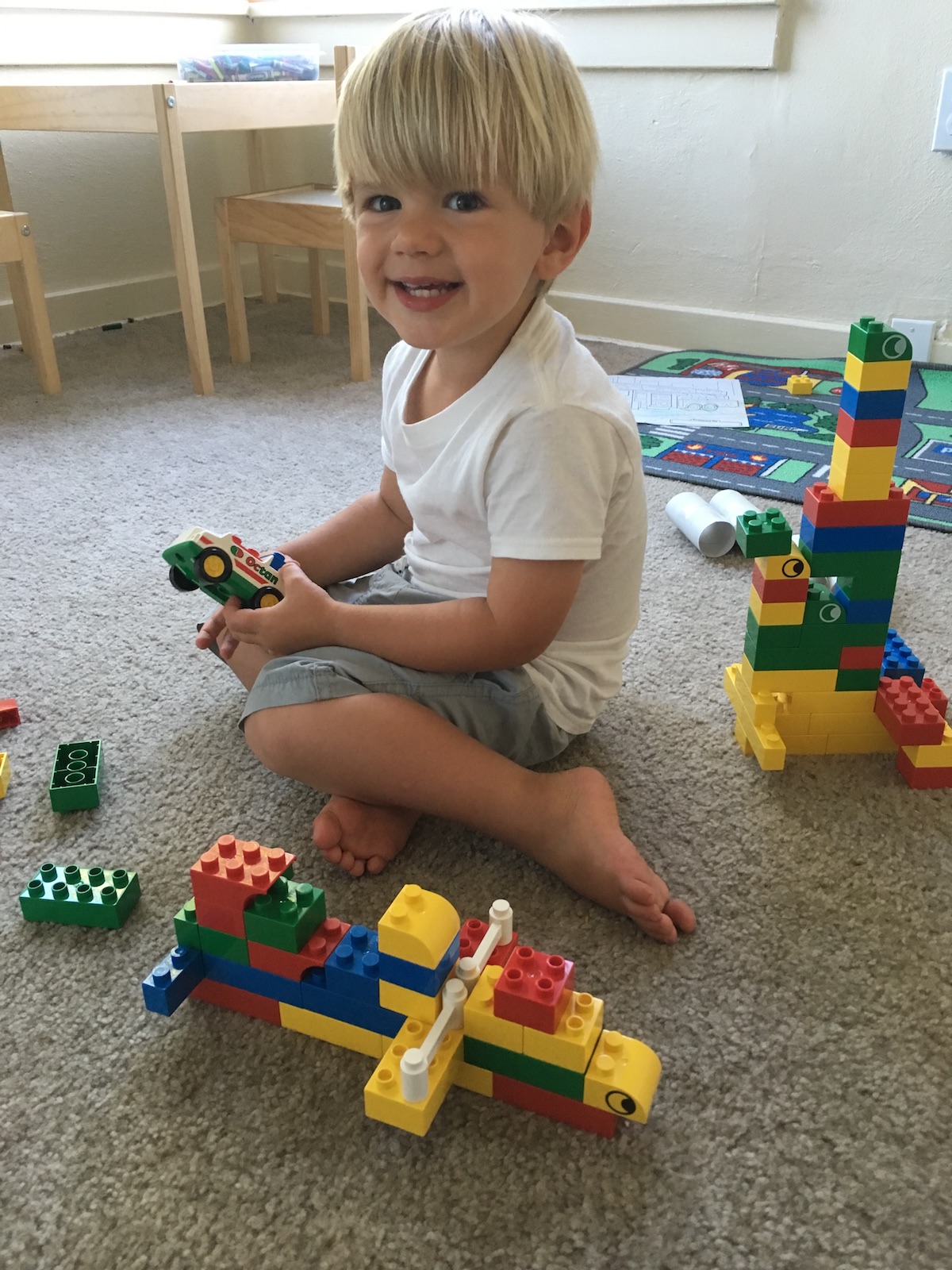
Toys will periodically get moved around based on the development of our children and how engaging those toys were.
I also try to make sure there is something for each child. As I said above, we don’t really believe in toy-child association/ownership but I do know that each of my children has certain preferences.
2) Experiment Often
We also typically include a few experimental toys – things we aren’t sure they are old enough for or that they didn’t like previously. We want to see if anything has changed.
To give you one example, I (somewhat selfishly) tried for a long time to rotate some of my old Star Wars action figures into the mix because I really wanted to do Darth Vader voices and such as I played with the boys. They never really took on but I kept trying every few months. On one such month, my eldest child, who was on an space shuttle kick, saw Boba Fett and exclaimed “It’s an astronaut!” That is now one of his favorite toys and I get to tell him all about Boba Fett (we focus on the astronaut part of things and not the killer-for-hire part).
I have a ton of other anecdotes about times where a seemingly never played with toy became a hit for a reason I couldn’t have predicted. That is some of the reason I am ok having what I consider to be an exorbitant amount of toys in our house – you never know when one will catch on. Thanks to the rotation process, the toys that haven’t caught on aren’t causing clutter in our living space, they are in storage space out of mind.
3) Putting Toys on Ice
We often put toys on ice for a period. That basically just means it won’t be rotated in. Some toys are great for a specific development state and sometimes we have no child in that state, so we might let a specific toy sit for six months and then introduce it gain.
Toys can also go on ice if they become frustrating to either a child or an adult. Our space tops toy was a great family activity, we parents could launch the tops and the boys enjoyed chasing the spinning tops. Eventually our eldest wanted to launch the tops but didn’t quite have the strength, which caused a lot of frustration for him. We put it on ice for a bit until and then tried again after he had grown a bit more and he was then able to operate it. Putting it on ice helped ensure the toy is still loved while avoiding a frustration that we didn’t feel was of the productive/beneficial kind.
4) Requesting Rotations
Our eldest child, now 2 1/2, understands the rotation process and periodically asks for something specific. We’ve generally been encouraging of this as it helps teach him patience, delayed gratification and allows him an easy way to participate in a decision process that affects him. It also helps us make sure we create an engaging rotation for that week.
5) Slippage
Inevitably, there will be weeks where there are more toys at the end of the week than the beginning. Sometimes this happens because we get out a specific toy to help with a specific thing during the week, sometimes we grant a request early, sometimes a new toy is introduced to the house, and often we get out toys when company is coming to make sure there are enough and appropriate toys for whoever is coming over.
We don’t stress over this too much, we know that it will only be a few days before they rotate back and we have a small amount again. In rare cases, there are way too many things out and we’ll put a few back.
6) Don’t Always Play The Hits
It is important, though sometimes difficult, to rest the best toys. Sometimes we want to leave the legos out for an extra week because the boys have been doing so great with them. I think that if you wait until a toy goes stale, you’ve messed up the whole system. I push myself to rotate it while it is still hot, bring something else in and then know that it will come back hot next time.
7) Borrow Toys From Others Too
Along with rotating toys from the basement, we do a fair bit of borrowing/trading toys with other families, mainly our in-laws who live near by. I find it especially easy since we already have an established practice of rotation – having random toys appear and disappear isn’t strange for our children, they don’t know the difference if the toys go into our basement or someone else’s house.
Borrowing toys creates the same benefits as rotating toys in that it allows children to play with new things for a period. It has the added benefit that it doesn’t increase the storage space needed in the basement for you since you are drawing from a pool stored at other houses.
I’ve heard about companies that are popping up in this space – I think that is a great idea. I’m not sure the business model is sustainable based on the availability & size, but if you don’t have friends with kids to trade with, a service is a great place to start.
8) Certain Toys Have Specific Homes
We have a few items that live in a specific place. The magnetic letters live on the fridge, the toy workbench lives next to my work bench in the garage, the water toys live on the porch in the summer and get put away in the winter, etc.
Update January 2018
A year later and I wanted to reflect back and share some updates I’ve learned since the original writing.
In the philosophy section I mentioned a few things we’ve worked hard to fight for that are a bit unique. We now have a few toys that belong to a specific child, this is especially true of gifts during the period right after they receive them. We generally try to limit this and even with their specific toys, require sharing.
Though we have tried not to make a big deal out of new toys, my oldest (almost 4) is now starting to understand the concept of gifts at birthdays and is starting to ask for things. We’ve directed that attention towards him being able to work to earn money to buy things he wants. Recently he earned a bunch of money helping do yard work which he spent on two sets of Legos, one for him and another for his brother (unprompted actually!). We’re encouraging of him learning the value of hard work and right now toys and sweets happen to be the best motivators.
In the toy selection section I mentioned I hadn’t bought my children any new toys. There have now been a few more exceptions. There were some specific toys I’d seen them do well with and wanted to introduce but couldn’t find used, in these cases I’m find buying something new.
Thinking of buying toys, I think of a true cost of toys in terms cost per hours of play. I’ve probably spent close to $300 on Magna-Tiles & Legos, some new some used, but those toys get played with 20+ hours per week and last for generations. Their true cost is actually much lower than some cheap novelty that will break after one day.
You can do a similar calculation with storage size vs hours of play to see which toys are worth their space. It is also important to keep in mind the toy selection standards I mentioned above. The cheapest per hour and smallest amount of space is always free shows streamed from a tablet but using that as the only (or even primary) source of entertainment for kids doesn’t live up to our standards.
The only thing I updated about the rotation process is that I changed it to Wednesday. I found Monday was the easiest day of the week for my wife because the kids were worn out from a fun weekend and she was fresh from having me be around to help. Wednesday rotations helped get over the mid week hump.
1. That’s an epic train set.
2. I really like the idea of introducing unwrapped toys to avoid the stimulus of “new things”.
3. I can’t wait to explain to your children that you kept 14 surfboards in our shared studio apartment… There’s a beautiful contradiction here.
You an my mom should start a club where you can reminisce about what I used to be like. She loves to remind me of how messy I used to be as a child. It isn’t a contradiction if that is in the past and we are growing – it is a mark of progress.